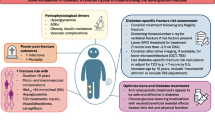Abstract
We have performed a 2-year prospective double-masked study to determine whether the bisphosphonate pamidronate can prevent bone loss in postmenopausal women and its optimal dosage regimen. One hundred and twenty-one such women (mean ± SD age 57.6±3.4 years; mean ± SD time since menopause 7.5±3.5 years) were randomized to receive either oral pamidronate (300 mg/day) for 4 weeks every 4 months (group A), oral pamidronate (150 mg/day) for 4 weeks every 2 months (group B) or identical placebo capsules (group C). Bone mineral density (BMD) measurements at the lumbar spine and proximal femur were performed at baseline and at 6-month intervals for 2 years using dual-energy X-ray absorptiometry. BMD at the lumbar spine (L2–4) increased significantly in groups A and B after 2 years of treatment (mean ± SD 2.8±2.1% and 3.0±2.9% respectively, bothp<0.001) but decreased in the placebo group (−1.6±3.1%,p<0.01). Identical results were seen for BMD at the femoral neck, which increased significantly in groups A and B after 2 years of treatment (1.2±2.3% and 1.3±2.9% respectively, bothp<0.05) but decreased in the placebo group (−1.9±3.9%,p<0.05). There were significant differences over 2 years between the groups at all anatomical sites (lumbar spine, femoral neck and trochanteric region, allp<0.001; Ward's triangle,p<0.01). However, there were no significant differences between groups A and B, suggesting that the two treatment regimens were equally effective in conserving BMD. There were, however, marked differences in tolerability between the two treatment regimens: 13 women (34%) in group A withdrew from the study because of side-effects, but only 5 women (12%) in group B, which was comparable with placebo. These data demonstrate that intermittent oral pamidronate will prevent bone loss from the lumbar spine and proximal femur of postmenopausal women, and that the more frequent but lower dose regimen is well tolerated.
Similar content being viewed by others
References
Reistsma PH, Bijvoet OLM, Verlinden-Ooms H, et al. Kinetic studies of bone and mineral metabolism during treatment with (3-amino-l-hydroxypropylidene)-l,l-bisphosphonate (APD) in rats. Calcif Tissue Int 1980;32:145–57.
Schenk R, Eggli P, Fleisch H, et al. Quantitative morphometric evaluation of the inhibitory activity of new aminobisphosphonates on bone resorption in the rat. Calcif Tissue Int 1986;38:342–9.
Harnich HIJ, Bijvoet OLM, Blanksma HJ, et al. Efficacious management with aminobisphosphonate (APD) in Paget's disease of bone. Clin Orthop 1987;217:79–98.
Harnich HIJ, Bijvoet OLM, Plantingh AST, et al. Role of bone and kidney in tumour-induced hypercalcaemia and its treatment with bisphosphonate and sodium chloride. Am J Med 1987;82:1133–42.
Reid IR, King AR, Alexander CJ, et al. Prevention of steroid-induced osteoporosis with (3-amino-l-hydroxypropylidene)-l,l-bisphosphonate (APD). Lancet 1988;1:143–6.
Devogelaer JP, Huaux JP, Nagant de Deuxchaisnes C. Bisphosphonate therapy with APD in involutional osteoporosis with vertebral crush fractures. In: Christiansen C, Johansen JS, Riis BJ, editors. Osteoporosis. Denmark: Osteopress ApS, 1987:950–1.
Valkema R, Vismans F-JFE, Papapoulos SE, et al. Maintained improvement in calcium balance and bone mineral content in patients with osteoporosis treated with the bisphosphonate APD. Bone Miner 1989;5:183–92.
Fromm GA, Vega E, Plantalech L, et al. Differential action of pamidronate on trabecular and cortical bone in women with involutional osteoporosis. Osteoporosis Int 1991;1:129–33.
Thiebaud D, Burckhardt P, Melchior J, et al. Two years' effectiveness of intravenous pamidronate (APD) versus oral fluoride for osteoporosis occurring in the postmenopause. Osteoporosis Int 1994;4:76–83.
Reid IR, Wattie DJ, Evans MC, et al. Continuous therapy with pamidronate, a potent bisphosphonate in postmenopausal osteoporosis. J Clin Endocrinol Metab 1994;79:1595–9.
Lees B, Stevenson JC. An evaluation of dual-energy X-ray absorptiometry and comparison with dual-photon absorptio-metry. Osteoporosis Int 1992;2:146–52.
Heaney RP. The bone-remodelling transient: implications for the interpretation of clinical studies of bone mass change. J Bone Miner Res 1994;9:1515–23.
Harris ST, Gertz BJ, Genant HK, et al. The effect of short-term treatment with alendronate on vertebral density and biochemical markers of bone remodelling in early postmenopausal women. J Clin Endocrinol Metab 1993;76:1399–406.
Reginster JY, Deroisy R, Denis D, et al. Prevention of postmenopausal bone loss by tiludronate. Lancet 1989;2:1469–71.
Evans RA, Somers NM, Dumstan CR, et al. The effect of low-dose cyclical etidronate and calcium on bone mass in early postmenopausal women. Osteoporosis Int 1993;3:71–5.
Filipponi P, Pedetti M, Fedell L, et al. Cyclical clodronate is effective in preventing postmenopausal bone loss: a comparative study with trancutaneous hormone replacement therapy. J Bone Miner Res 1995;10:697–703.
Fleisch H. New bisphosphonates in osteoporosis. Osteoporosis Int 1993;3(Suppl 2):S15–22.
Lufkin EG, Argueta R, Whitaker MD, et al. Pamidronate: an unrecognised problem in gastrointestinal tolerability. Osteoporosis Int 1994;4:320–322.
Adamson BB, Gallacher SJ, Byars J, et al. Mineralisation defects with pamidronate therapy for Paget's disease. Lancet 1993;342:1459–60.
Grynpas MD, Acito A, Dimitriu M, et al. Changes in bone mineralisation, architecture and mechanical properties due to long-term (1 year) administration of pamidronate (APD) to adult dogs. Osteoporosis Int 1992;2:74–81.
Ferretti JL, Cointry G, Capozza R, et al. Biochemical effects of the full range of useful doses of (3-amino-l-hydroxypropylidene)-1,1-bisphosphonate (APD) on femur diaphyses and cortical bone tissue in rats. Bone Miner 1990;11:111–22.
Author information
Authors and Affiliations
Rights and permissions
About this article
Cite this article
Lees, B., Garland, S.W., Walton, C. et al. Role of oral pamidronate in preventing bone loss in postmenopausal women. Osteoporosis Int 6, 480–485 (1996). https://doi.org/10.1007/BF01629581
Received:
Accepted:
Issue Date:
DOI: https://doi.org/10.1007/BF01629581




